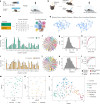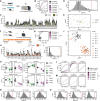Analysis of behavioral flow resolves latent phenotypes
- PMID: 39533008
- PMCID: PMC11621029
- DOI: 10.1038/s41592-024-02500-6
Analysis of behavioral flow resolves latent phenotypes
Abstract
The accurate detection and quantification of rodent behavior forms a cornerstone of basic biomedical research. Current data-driven approaches, which segment free exploratory behavior into clusters, suffer from low statistical power due to multiple testing, exhibit poor transferability across experiments and fail to exploit the rich behavioral profiles of individual animals. Here we introduce a pipeline to capture each animal's behavioral flow, yielding a single metric based on all observed transitions between clusters. By stabilizing these clusters through machine learning, we ensure data transferability, while dimensionality reduction techniques facilitate detailed analysis of individual animals. We provide a large dataset of 771 behavior recordings of freely moving mice-including stress exposures, pharmacological and brain circuit interventions-to identify hidden treatment effects, reveal subtle variations on the level of individual animals and detect brain processes underlying specific interventions. Our pipeline, compatible with popular clustering methods, substantially enhances statistical power and enables predictions of an animal's future behavior.
© 2024. The Author(s).
Conflict of interest statement
Competing interests: E.C.O. was employed by F. Hoffmann-La Roche AG Switzerland at the time of study conduct and manuscript submission. O.S. was funded by a Roche postdoctoral fellowship. The other authors declare no competing interests.
Figures










References
-
- Kafkafi, N., Yekutieli, D., Yarowsky, P. & Elmer, G. I. Data mining in a behavioral test detects early symptoms in a model of amyotrophic lateral sclerosis. Behav. Neurosci.122, 777–787 (2008). - PubMed
-
- Kafkafi, N., Yekutieli, D. & Elmer, G. I. A data mining approach to in vivo classification of psychopharmacological drugs. Neuropsychopharmacology34, 607–623 (2009). - PubMed
-
- Mathis, A. et al. DeepLabCut: markerless pose estimation of user-defined body parts with deep learning. Nat. Neurosci.21, 1281–1289 (2018). - PubMed
MeSH terms
LinkOut - more resources
Full Text Sources

